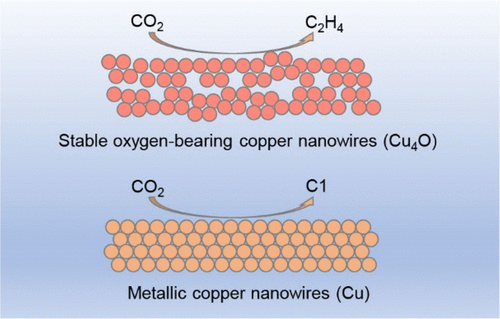当前位置:
X-MOL 学术
›
J. Am. Chem. Soc.
›
论文详情
Our official English website, www.x-mol.net, welcomes your
feedback! (Note: you will need to create a separate account there.)
Atypical Oxygen-bearing Copper Boosts Ethylene Selectivity toward Electrocatalytic CO2 Reduction
Journal of the American Chemical Society ( IF 14.4 ) Pub Date : 2020-06-08 , DOI: 10.1021/jacs.0c01562 Wei Zhang 1 , Chuqiang Huang 1 , Qin Xiao 1 , Luo Yu 1, 2 , Ling Shuai 1 , Pengfei An 3 , Jing Zhang 3 , Ming Qiu 1 , Zhifeng Ren 2 , Ying Yu 1
Journal of the American Chemical Society ( IF 14.4 ) Pub Date : 2020-06-08 , DOI: 10.1021/jacs.0c01562 Wei Zhang 1 , Chuqiang Huang 1 , Qin Xiao 1 , Luo Yu 1, 2 , Ling Shuai 1 , Pengfei An 3 , Jing Zhang 3 , Ming Qiu 1 , Zhifeng Ren 2 , Ying Yu 1
Affiliation

|
Oxygen-bearing copper (OBC) has been widely studied for enabling the C-C coupling of the electrocatalytic CO2 reduction reac-tion (CO2RR) since this is a distinctive hallmark of strongly correlated OBC systems and may benefit many other Cu-based cata-lytic processes. Unresolved problems, however, include the instability of, and limited knowledge regarding, OBC under realistic operating conditions, raising doubts about its role in CO2RR. Here, an atypical and stable OBC catalyst with a hierarchical pore and nanograin-boundary structure was constructed and was found to exhibit efficient CO2RR for production of ethylene with a Faradaic efficiency of 45 percent at a partial current density of 44.7 mA cm-2 in neutral media, and the ethylene partial current density is nearly 26 and 116 times as that of oxygen-free copper (OFC) and commercial Cu foam, respectively. More importantly, the structure-activity relationship in CO2RR was explored through a comprehensive analysis of experimental data and computa-tional techniques, thus increasing the fundamental understanding of CO2RR. A systematic characterization analysis suggests that atypical OBC (Cu4O) was formed and that it is stable even at -1.00 V [(vs. reversible hydrogen electrode (RHE)]. Density func-tional theory calculations show that the atypical OBC enables control over CO adsorption and dimerization, making it possible to implement a preference for the electrosynthesis of ethylene (C2) products. These results provide insight into the synthesis and structural characteristics of OBC, as well as its interplay with ethylene selectivity.
中文翻译:

非典型含氧铜提高乙烯对电催化 CO2 还原的选择性
含氧铜 (OBC) 已被广泛研究用于实现电催化 CO2 还原反应 (CO2RR) 的 CC 耦合,因为这是强相关 OBC 系统的独特标志,并且可能有益于许多其他基于铜的催化过程. 然而,未解决的问题包括在实际操作条件下 OBC 的不稳定性和有限的知识,这引发了对其在 CO2RR 中的作用的怀疑。在这里,构建了一种具有分级孔和纳米晶界结构的非典型且稳定的 OBC 催化剂,并发现在中性部分电流密度为 44.7 mA cm-2 时,它表现出高效的 CO2RR 以生产乙烯,法拉第效率为 45%介质,乙烯部分电流密度是无氧铜(OFC)和商业泡沫铜的近26倍和116倍,分别。更重要的是,通过对实验数据和计算技术的综合分析,探索了CO2RR中的构效关系,从而增加了对CO2RR的基本认识。系统表征分析表明,形成了非典型 OBC (Cu4O) 并且即使在 -1.00 V [(相对于可逆氢电极 (RHE)] 下也稳定)。密度泛函理论计算表明,非典型 OBC 能够控制 CO吸附和二聚化,使得对乙烯 (C2) 产物的电合成的优先选择成为可能。这些结果提供了对 OBC 的合成和结构特征的洞察,以及它与乙烯选择性的相互作用。通过对实验数据和计算技术的综合分析,探索了 CO2RR 的构效关系,从而增加了对 CO2RR 的基本认识。系统表征分析表明,形成了非典型 OBC (Cu4O) 并且即使在 -1.00 V [(相对于可逆氢电极 (RHE)] 下也稳定)。密度泛函理论计算表明,非典型 OBC 能够控制 CO吸附和二聚化,使得对乙烯 (C2) 产物的电合成的优先选择成为可能。这些结果提供了对 OBC 的合成和结构特征的洞察,以及它与乙烯选择性的相互作用。通过对实验数据和计算技术的综合分析,探索了 CO2RR 中的构效关系,从而增加了对 CO2RR 的基本理解。系统表征分析表明,形成了非典型 OBC (Cu4O) 并且即使在 -1.00 V [(相对于可逆氢电极 (RHE)] 下也稳定)。密度泛函理论计算表明,非典型 OBC 能够控制 CO吸附和二聚化,使得对乙烯 (C2) 产物的电合成的偏好成为可能。这些结果提供了对 OBC 的合成和结构特征的洞察,以及它与乙烯选择性的相互作用。使得可以优先选择乙烯 (C2) 产品的电合成。这些结果有助于深入了解 OBC 的合成和结构特征,以及其与乙烯选择性的相互作用。使得可以优先选择乙烯 (C2) 产品的电合成。这些结果有助于深入了解 OBC 的合成和结构特征,以及其与乙烯选择性的相互作用。
更新日期:2020-06-08
中文翻译:

非典型含氧铜提高乙烯对电催化 CO2 还原的选择性
含氧铜 (OBC) 已被广泛研究用于实现电催化 CO2 还原反应 (CO2RR) 的 CC 耦合,因为这是强相关 OBC 系统的独特标志,并且可能有益于许多其他基于铜的催化过程. 然而,未解决的问题包括在实际操作条件下 OBC 的不稳定性和有限的知识,这引发了对其在 CO2RR 中的作用的怀疑。在这里,构建了一种具有分级孔和纳米晶界结构的非典型且稳定的 OBC 催化剂,并发现在中性部分电流密度为 44.7 mA cm-2 时,它表现出高效的 CO2RR 以生产乙烯,法拉第效率为 45%介质,乙烯部分电流密度是无氧铜(OFC)和商业泡沫铜的近26倍和116倍,分别。更重要的是,通过对实验数据和计算技术的综合分析,探索了CO2RR中的构效关系,从而增加了对CO2RR的基本认识。系统表征分析表明,形成了非典型 OBC (Cu4O) 并且即使在 -1.00 V [(相对于可逆氢电极 (RHE)] 下也稳定)。密度泛函理论计算表明,非典型 OBC 能够控制 CO吸附和二聚化,使得对乙烯 (C2) 产物的电合成的优先选择成为可能。这些结果提供了对 OBC 的合成和结构特征的洞察,以及它与乙烯选择性的相互作用。通过对实验数据和计算技术的综合分析,探索了 CO2RR 的构效关系,从而增加了对 CO2RR 的基本认识。系统表征分析表明,形成了非典型 OBC (Cu4O) 并且即使在 -1.00 V [(相对于可逆氢电极 (RHE)] 下也稳定)。密度泛函理论计算表明,非典型 OBC 能够控制 CO吸附和二聚化,使得对乙烯 (C2) 产物的电合成的优先选择成为可能。这些结果提供了对 OBC 的合成和结构特征的洞察,以及它与乙烯选择性的相互作用。通过对实验数据和计算技术的综合分析,探索了 CO2RR 中的构效关系,从而增加了对 CO2RR 的基本理解。系统表征分析表明,形成了非典型 OBC (Cu4O) 并且即使在 -1.00 V [(相对于可逆氢电极 (RHE)] 下也稳定)。密度泛函理论计算表明,非典型 OBC 能够控制 CO吸附和二聚化,使得对乙烯 (C2) 产物的电合成的偏好成为可能。这些结果提供了对 OBC 的合成和结构特征的洞察,以及它与乙烯选择性的相互作用。使得可以优先选择乙烯 (C2) 产品的电合成。这些结果有助于深入了解 OBC 的合成和结构特征,以及其与乙烯选择性的相互作用。使得可以优先选择乙烯 (C2) 产品的电合成。这些结果有助于深入了解 OBC 的合成和结构特征,以及其与乙烯选择性的相互作用。











































 京公网安备 11010802027423号
京公网安备 11010802027423号